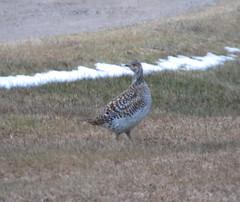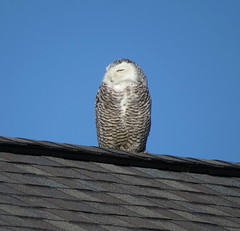Bellevue Bottoms, Boone County Cliffs, The Oxbow, Lost Bridge, Smith Tract County Park
It was an early morning risin’ as I set off from my local UDF with coffee in hand towards Jon’s house. Today’s destination is our yearly trip to Boone County Cliffs, which is the biggest 78 acre park I’ve ever visited. But first we’re passing the turn off to the “cliffs” and heading towards a couple of dead end roads which recently has had some good bird reports. Especially Henslow Sparrows and Northern Bobwhites. We’re traveling to an area of Boone County Kentucky that is called Bellevue Bottoms. With it’s close proximity to the Ohio River and Aurora Indiana this part of the tri-state is new to me and has so much potential for some good birding in the future.
I’m assuming at one time these 2 roads (Horsley Ferry and Aurora Ferry Roads) had serviceable ferries that crossed the river, and being dead end there wasn’t too much traffic and walking on the road wasn’t an issue. Northern Bobwhite, Bank Swallow, Yellow-breasted Chat, Orioles, Eastern Kingbird, and Vireos were some of the more numerous species seen. After leaving this beautiful rural setting it was off to Boone County Cliffs.
As we turned onto Middleboro Road we are greeted with a singing Eastern Phoebe perched on a bridge post. And as was the case for the day no camera within reach. So I opted to leave it behind today and just focus on the birds. Sometimes when I go birding I focus too much on getting a decent picture of the bird than concentrating on what’s important, the actual bird. Then when I’m scrambling to retrieve my camera from it’s case, the bird is gone.
Boone County Cliffs is without a doubt in my top 5 places to visit within my 50 mile radius of home. Great hiking trail that winds on for 2 miles deep in some beautiful deciduous woods. A great variety of birds await anyone who visits this gem. However today the target birds are Kentucky and Worm-eating Warblers. Worm-eating warblers especially habitat specific and Boone County Cliffs are noted for multiple nesting “Wormies”. Since I starting visiting here I’ve not missed on this bird, it’s that reliable. With just a good set of ears and some patience anyone can either see of hear them. There call is a high pitched thrill that’s difficult to pick up at first if you’re not used to hearing it. Which was the case this morning. Jon was hearing one in the distance, but I couldn’t pick it up till I heard one close and got “tuned in”.
We were greeted with over active Louisiana Waterthrush’s as multiple birds chased each other around in the area of a small stream that cascades down towards the road we came in on. A thick canopy and under growth close in on both sides of the trail as we started to climb towards the area of the cliffs. Vireos, Flycatchers, Orioles, Tanagers, and my most favorite bird song, the Wood Thrush were everywhere.
This 2 mile trail finally reached it’s highest point, then started to level out with a gently rolling path that followed the contour of the ridge top. We’d pause and listen if a bird peaked our interest, or if a sudden movement caught our eye. As we made our way deeper into the woods we started to hear Wormies a little closer and had a great look of an Ovenbird. The one thing about Ovenbirds and Kentucky warblers is that their calls are very similar. And after we really listened, at both a Kentucky Warbler and an Ovenbird we finally were able to tell the difference when we heard more sing later on.
THEN OUR SOLITUDE WAS BROKEN BY GUN FIRE!
We had heard voices behind us for some time, but being a pretty popular place to go birding we never gave it much thought as this group of people were several hundred yards behind us the whole time. We didn’t know if they were birders or not, but there loud talking made us think they were just hiking. That was until one of the idiots discharged their gun, which in turned scared the shit out of the both of us. Jon then yells back at them that we’re up here and not to shoot their gun again. We reported the incident to the police and made a hasty retreat to our car, not wanting to run into some pissed off locals with a loaded gun. A very disturbing end to a great birding outing.
We took the long way home with stops at the Oxbow were a group of Great Egrets yielded one Snowy Egret, and a couple Prothonotary Warblers. After leaving the Oxbow we made our way to Smith tract County Park. In the past a good spot for Bell’s Vireo and Lark Sparrows. However the area where they’re usually sen has been taken over by a company that is using the area for a huge pipe line project. I real bummer. But on a bright note we did get some good looks as a Grasshopper Sparrow as it sang from the top of some weed.
And since it was an early day we called it over after leaving Smith Tract. Despite the disturbing end to our visit at “The Cliffs”, it was a great day of birding.
Notable birds for the day include:
- American Kestrel
- Black Vulture
- Turkey Vulture
- Dickcissel
- Yellow Warbler
- Common Yellowthroat
- Yellow-throated Warbler
- Cerulean Warbler
- Hooded warbler
- Worm-eating Warbler
- Kentucky Warbler
- Louisiana Waterthrush
- Northern Parula
- Yellow-breasted Chat
- Field Sparrow
- Chipping Sparrow
- House Sparrow
- Grasshopper Sparrow
- Song Sparrow
- Cedar Waxwing
- Gray Catbird
- Red-winged Blackbird
- Common grackle
- Common Crow
- Northern Cardinal
- Tufted Titmouse
- Carolina Chickadee
- Carolina Wren
- House Wren
- Indigo Bunting
- Baltimore Oriole
- Orchard Oriole
- Brown Thrasher
- Northern Mockingbird
- Mourning Dove
- Northern Bobwhite
- American goldfinch
- Blue-gray Gnatcatcher
- Great-creasted Flycatcher
- Willow flycatcher
- Acadian Flycatcher
- Eastern Kingbird
- Downy Woodpecker
- Hairy Woodpecker
- Red-bellied Woodpecker
- Pileated Woodpecker
- Great Blue Heron
- Green Heron
- Great Egret
- Snowy Egret
- Canada Goose
- Mallard
- Purple Martin
- Tree Swallow
- Northern Rough-winged Swallow
- Bank Swallow
- Cliff Swallow
- Barn Swallow
- Red-eyed Vireo
- White-eyed Vireo
- Warbling Vireo
- Chimney Swift
- Ruby-throated Hummingbird
- Double-creasted Cormorant
- Blue jay
- Wood Thrush
- American Robin
- Yellow-billed Cuckoo
- Scarlet Tanager
- Belted Kingfisher
- Spotted Sandpiper
- Common Loon
- White-breasted Nuthatch
 Just like last year, a Mississippi Kite has appeared at the same location in Loveland Ohio. The report came in this afternoon of a sighting at 11:30 this morning. Whether it’s the same bird or not is hard to determine, but if the rains hold off long enough I’ll be making a trip over there shortly. More to come.
Just like last year, a Mississippi Kite has appeared at the same location in Loveland Ohio. The report came in this afternoon of a sighting at 11:30 this morning. Whether it’s the same bird or not is hard to determine, but if the rains hold off long enough I’ll be making a trip over there shortly. More to come.
































